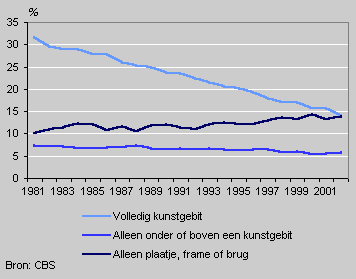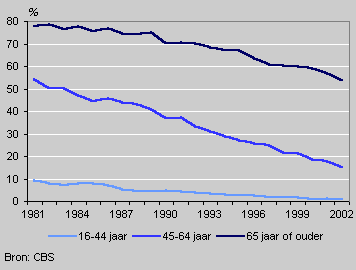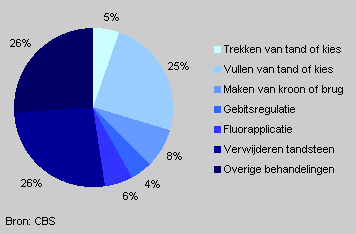Fewer and fewer people with dentures

The percentage of people with complete dentures is still decreasing in the Netherlands. More and more people go to their dentists at least once a year.
Half as many people with complete dentures
The percentage of people wearing complete dentures more than halved between 1981 and 2002. Inn 2002 just under 15 percent of the population had a complete set of dentures.
Dental prostheses

The decrease was largest in the age group 45-64 years: nearly 40 percent points. For the over-65s the proportion wearing complete dentures fell from three-quarters in 1981 to about half in 2002.
People with complete dentures by age

The percentage of people with only upper or lower dentures fell only marginally in the same period. The proportion with a dental plate, frame prosthesis or bridgework rose slightly.
More people go to the dentist
The percentage of the Dutch population who visit their dentist at least once a year rose from 60 to nearly 80 percent between 1981 and 2002. The average number of dentist visits per person was 2.2 in 2002. This average has been reasonably stable for the last twenty years.
Men go to the dentist about just as often as women. People with private insurance go more often than those insured under the national health insurance fund, and higher educated people go more often than people with lower educational levels. People aged 65 years or older visit their dentists less often than younger people. This is because more of them have dentures.
Regular check-ups
Three-quarters of dentist visits are for a regular check-up, or treatment ensuing from such a check-up. One in ten visits are because the patient has toothache. Older people are more likely to visit their dentists because of toothache than younger people.
Fillings
If the check-ups are left out of account, one quarter of dental treatment consists of fillings in one or more teeth. Removing tartar also accounts for one quarter of treatment. The most drastic operation, tooth extraction, occurs only in one in twenty cases.
Dental treatment, 2002

Higher educated people are most interested in preserving their own teeth. Extractions are lowest in this group, while fillings, crowns and bridgework are done most. People with private insurance, too, are less likely to have teeth extracted and to have more fillings, crowns and bridgework than those insured under the national health insurance fund.
Orthodontic treatment is mainly given to children aged between 12 to 18 years. Fluoride treatment is only given to children under 18.
Ferdy Otten
Source: StatLine (Dutch only)